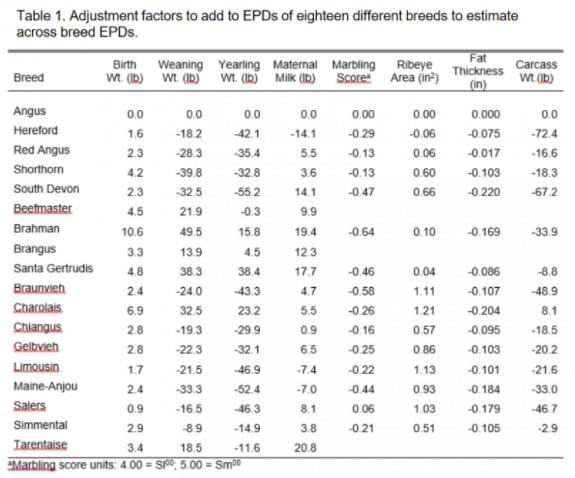Last week I posted an article detailing the rise of input costs over the last year, and offered a list of points for producers to consider with the goal of increasing revenues to help offset rising input costs. As I work through possible ways to increase revenue over the next few weeks, the first point to consider is Sire Selection. This is a topic that I have written and spoke about many times before, but I still feel that for many cattlemen there is tremendous room for improvement in how they select their herd sires.
As stated in last week’s article, if you want to increase revenue on a cow/calf operation you need to sell more pounds and/or make the pounds you sell more valuable. Calf performance (which is greatly influenced by genetics) plays a large roll in bringing either of those scenarios to fruition.
Foundational Points to Remember:
- Cow genetics and mothering ability definitely affect the performance of individual calves, but the sire provides half of the genetic makeup for many calves, meaning sire genetics have a major affect on the overall value of the calf crop.
- Genetics set the upper limit for animal performance. Good management can not overcome poor genetics. Poor management can prevent animals from reaching their genetic potential.
The positive results of selecting sires based on genetic merit will be the most evident if you focus on traits that will directly affect your revenue potential. Think about how/when your calves will be marketed and focus on traits that will directly impact their value at the time they are marketed. Again, this will relate to more pounds (growth traits, like WW) and/or more valuable pounds (carcass traits, etc).
There are plenty of tools available to help you make sire selection decisions based (at least in part) on the sire’s genetic merit (EPDs, Selection Indexes, etc.). There are links below to other articles detailing these tools and how to use them, or if you prefer contact me directly. I’ll always be happy to discuss bull selection. Like so many other things around the farm, using these selection tools takes some time and effort, but doing so will increase the performance and hopefully the value of your calf crop.
Beyond the performance traits that the selection tools focus on, there are other factors that should be considered when selecting a sire to maximize revenue. Factors like color and the presence or absence of horns can impact the value of calves. These might seem knit-picky points but collectively they can impact the value of a calf crop. Think about the value difference between a group of mixed colored, horned calves and a group polled black calves of identical weights.
Obviously, bulls of different breeds will have considerably different genetic makeups – changing breeds may generate greater increases in performance than just seeking out genetically superior individuals within the breed that you are currently using. There is a lot that should go into the decision to change the breed of bull you use – think critically about why you use the breed you use. Make sure those reasons have economic justification. Breed selection should be based on production/marketing goals balanced against the limitations of your production system/environment.
If generating replacement heifers is driving your breed selection, think about how many replacements you really need each year and if total revenues could be increased by using multiple breeds of bulls. Not every cow needs to be bred with the goal of producing a replacement (ie.to sires selected based on maternal traits). The majority of cows can be bred to sires selected based market traits that drive revenue.
The impact of heterosis (hybrid vigor) is another valuable point relating to breed selection. There is a considerable bump in performance associated with crossbred calves. The amount of heterosis (the tendency of a crossbred individual to show qualities superior to those of both parents: definition courtesy of Oxford Languages) expressed in a calf is directly related to how genetically diverse the parents are. If the breed type of your cows is similar to the breed type of your bulls heterosis will be minimal. While there is considerable genetic variation between breeds, in relation to heterosis, the most appreciable differences are seen when the British breeds are compared to the Continental breeds and when British or Continental breeds are compared to Bos Indicus cattle.
Selecting the right breeding system and breed of sire is complicated and beyond the scope of this article. The goal here is to encourage critical evaluation of the system currently in place, and hopefully recognize if there is room for improvement. The resources linked below explore the topic in greater detail, and I would be happy to discuss it further one-on-one.

The chart above can be used to compare EPD values across breeds. This will allow you some predictive power relating to the potential value of your calf crop should you choose to change the breed of bull you use. See 2019 ACROSS-BREED EPD TABLE AND IMPROVEMENTS for complete tables and instructions for how to use them. Source: USDA Meat Animal Research Center (MARC)
Price is always a concern for producers when I discuss upgrading bulls, and rightfully so. Selecting a bull based on genetic merit does not necessarily mean you will have to spend considerably more than you otherwise would. It does mean that you will have to start looking and planning farther in advance. The increased investment will come in the form of time/effort needed to determine what you need and where to find it. In reality however, there may be a higher cash cost associated with buying a genetically superior bull. Keep in mind, subsequent calf performance must only generate additional revenue sufficient to surpass the difference in price between the genetically superior bull and the bull you would have otherwise selected to make it a worthwhile investment. Generally speaking, that is not too difficult to accomplish.
Source : ufl.edu